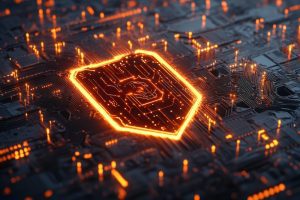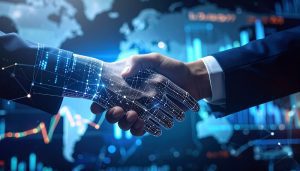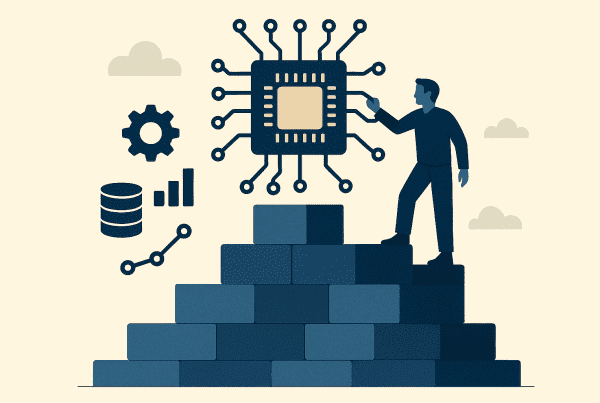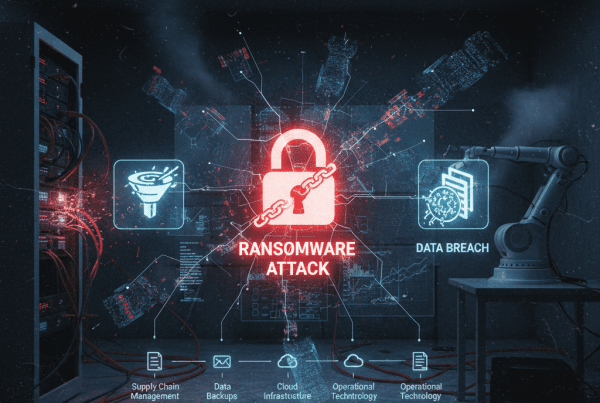Every breakthrough in technology creates new opportunities — and new risks. Artificial intelligence is no exception. In cybersecurity, it promises faster detection, more innovative prevention, and automated defenses that never sleep. Yet it also arms attackers with more sophisticated tactics, blurring the line between innovation and vulnerability.
For businesses, that tension is impossible to ignore. AI is already changing how organizations monitor their networks, handle incidents, and respond to threats. At the same time, it raises questions about reliability, oversight, and the unintended consequences of giving up so much control.
In this blog, we’ll explore the benefits AI brings to cybersecurity, the risks it introduces, and how businesses can use it responsibly without losing sight of the bigger picture.
The Benefits of AI in Cybersecurity
Faster Threat Detection and Response
Traditional security systems often take too long to detect an attack. By the time a human analyst notices suspicious activity, valuable data may already be compromised. AI-driven tools can analyze massive amounts of network data in real time, flagging unusual behavior within seconds.
For example, if login attempts suddenly spike in the middle of the night from an unfamiliar location, an AI-powered system can immediately alert security teams or even block access automatically. This speed drastically reduces the window of opportunity for criminals.
Predictive Capabilities
By analyzing patterns in network traffic and historical data, machine learning models can identify potential vulnerabilities before they escalate into full-blown breaches. This predictive ability enables businesses to patch vulnerabilities early, preventing problems rather than just responding to them.
Imagine a system that detects a server exhibiting signs of unusual activity, similar to systems that have been compromised elsewhere. AI can raise the alarm before attackers make their move, buying companies valuable time to reinforce their defenses.
Automation of Routine Tasks
Security professionals often spend countless hours reviewing logs, filtering alerts, and investigating minor incidents. AI helps by taking on much of this repetitive work, utilizing automated systems to filter through noise, identify genuine threats, and escalate the most serious cases.
AI doesn’t remove the need for human oversight. Instead, it allows security teams to spend more time on strategy, analysis, and complex decision-making while automation manages the constant monitoring.
Improved Accuracy Over Traditional Methods
False alarms are one of the biggest frustrations in cybersecurity. Too many alerts can overwhelm IT teams, causing them to miss the one that really matters. AI systems, trained on diverse data sets, can distinguish between harmless anomalies and actual threats more accurately than rule-based systems.
The longer an AI system operates, the more refined its detection becomes. It learns from both real and false threats, gradually improving its ability to recognize what’s dangerous and what’s not.
Scalability for Growing Businesses
As companies expand, so does the size of their attack surface. Hiring enough staff to cover every system and device isn’t always realistic. AI scales naturally, monitoring vast networks without requiring proportionally larger security teams.
For small and midsize businesses, this is especially valuable. AI enables access to advanced security monitoring that would otherwise be out of reach without a full in-house security operations center.

The Risks of AI in Cybersecurity
AI as a Double-Edged Sword
The same qualities that make AI valuable for defense also make it a powerful weapon in the hands of cybercriminals. Hackers are using it to craft convincing phishing emails, automate attacks, and even generate deepfake audio or video to impersonate executives.
While AI helps businesses detect unusual activity and respond more quickly, it also pushes attackers to develop more sophisticated tactics, raising the overall stakes in cybersecurity.
Over-Reliance on Automation
AI is powerful, but it isn’t perfect. Relying exclusively on automated defenses can create blind spots. If a system is tricked or bypassed, there may be no human oversight to catch the issue until it’s too late.
For example, a poisoned dataset (where attackers intentionally feed misleading information into an AI system) can cause the system to misidentify threats. Without a human team verifying results, businesses could develop a false sense of security.
Data Privacy and Bias
AI relies on vast amounts of data to learn patterns, enhance accuracy, and make informed decisions. Collecting and processing that data can create privacy concerns, especially if sensitive customer or employee information is involved. Mishandling this information could expose a business to regulatory fines or reputational damage.
AI systems can also inherit biases from the data they’re trained on. If the training set doesn’t reflect the full range of possible scenarios, the system might overlook certain threats or misclassify activity. This could leave specific vulnerabilities unprotected.
High Implementation Costs and Complexity
Deploying AI in cybersecurity is not as simple as installing a new program. It requires skilled specialists to configure, monitor, and continuously improve the system. For many businesses, the initial investment in both technology and expertise can be significant.
Small and midsize businesses may struggle to balance the benefits with the cost. Without proper planning, AI adoption could become more of a burden than a safeguard.
Adversarial Attacks on AI Systems
Hackers are not only using AI offensively; they are also targeting AI itself. Adversarial attacks involve deceiving machine learning models into making incorrect decisions. For instance, attackers might manipulate input data in subtle ways that cause the AI to misclassify a threat as harmless.
These attacks highlight the need for ongoing vigilance. If AI is treated as a “set it and forget it” solution, it could quickly become a liability.
Striking the Balance: Maximizing Benefits While Reducing Risks
The Human + AI Approach
The most effective cybersecurity strategies combine automation with human expertise. AI manages the scale and speed of monitoring, while people bring judgment, context, and creativity to the decision-making process. Security teams should review and confirm AI-generated alerts, ensuring that the right issues are addressed and that serious threats are not overlooked.
Regular Auditing and Testing of AI Models
AI systems should not remain static. Regular audits help ensure accuracy and reliability. “Red team” testing — where security experts simulate attacks against the system — can reveal weaknesses before real attackers do.
Regular testing and updates are necessary to maintain the reliability of these security systems over time.
Data Governance and Privacy Safeguards
Organizations need clear policies for how data used in AI systems is collected, stored, and protected. Strong governance ensures that sensitive data is handled responsibly and reduces the risk of breaches tied to training datasets.
Maintaining transparency about how AI operates also helps build trust with customers and stakeholders.
Cybersecurity Partnerships and Outsourcing
Not every business has the budget or in-house expertise to develop and manage advanced AI security tools independently. Many turn to Managed Services providers that offer AI-driven cybersecurity as part of a broader package. These partnerships give businesses access to the same level of protection as larger enterprises, without the high upfront costs or the challenge of hiring and retaining specialized talent.
Employee Awareness and Training
Technology alone can’t block every threat. Something as simple as an employee clicking a link in a phishing email or reusing a weak password is often what opens the door to a bad actor. Regular training helps staff spot suspicious messages, use stronger password practices, and understand the role their day-to-day actions play in protecting company data.
When paired with AI monitoring, a workforce that knows what to look for and how to respond quickly adds a layer of protection no software can fully replace.
Finding the Right Balance
AI is transforming how companies approach cybersecurity, from identifying suspicious activity more quickly to assisting teams in managing the constant stream of alerts. At the same time, it presents challenges — including the cost of adoption, the need for skilled personnel to manage it, and the risk that attackers will exploit the same tools for their own advantage.
The most innovative approach is balance. Businesses that treat AI as support for their security teams, rather than a replacement, are more likely to see real results. That means pairing automation with human oversight, regularly testing systems, and ensuring employees understand how their everyday actions impact security.
AI brings speed and precision to cybersecurity. When integrated wisely, it provides businesses with a clear advantage in an environment where threats evolve daily.
About Atlantic, Tomorrow’s Office
Atlantic, Tomorrow’s Office is a leading managed services provider offering managed IT, cybersecurity, office technology, business consulting, and digital transformation solutions. Focusing on helping mid-market businesses optimize their cybersecurity practices, enabling technology and operations, Atlantic delivers end-to-end solutions tailored to the evolving needs of today’s enterprises.
For the latest industry trends and technology insights, visit ATO’s main Blog page.






